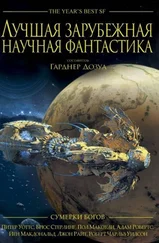Гарднер Дозуа - Mermaids!
Здесь есть возможность читать онлайн «Гарднер Дозуа - Mermaids!» весь текст электронной книги совершенно бесплатно (целиком полную версию без сокращений). В некоторых случаях можно слушать аудио, скачать через торрент в формате fb2 и присутствует краткое содержание. Год выпуска: 1986, ISBN: 1986, Издательство: Ace, Жанр: Фантастика и фэнтези, на английском языке. Описание произведения, (предисловие) а так же отзывы посетителей доступны на портале библиотеки ЛибКат.
- Название:Mermaids!
- Автор:
- Издательство:Ace
- Жанр:
- Год:1986
- ISBN:0-441-52567-9
- Рейтинг книги:5 / 5. Голосов: 1
-
Избранное:Добавить в избранное
- Отзывы:
-
Ваша оценка:
- 100
- 1
- 2
- 3
- 4
- 5
Mermaids!: краткое содержание, описание и аннотация
Предлагаем к чтению аннотацию, описание, краткое содержание или предисловие (зависит от того, что написал сам автор книги «Mermaids!»). Если вы не нашли необходимую информацию о книге — напишите в комментариях, мы постараемся отыскать её.
Mermaids! — читать онлайн бесплатно полную книгу (весь текст) целиком
Ниже представлен текст книги, разбитый по страницам. Система сохранения места последней прочитанной страницы, позволяет с удобством читать онлайн бесплатно книгу «Mermaids!», без необходимости каждый раз заново искать на чём Вы остановились. Поставьте закладку, и сможете в любой момент перейти на страницу, на которой закончили чтение.
Интервал:
Закладка:
Because, besides the legend of the mer- or mere , i.e., sea- , maid, there is the legend of the undine or ondine, a sort of river- or lake-dwelling equivalent, I have a theory that this may have preceded the mermaid one. Perhaps certain inland tribes (my theory goes) who not only could not swim but had never heard of people who could, coming upon, in their wanderings, a strange river, lake, or pool, and seeing a human form performing in the water after the manner of a water-creature—a fish—had no explanation for such a brief (we may assume) sighting other than that the creature in the water, though human-shaped, was at least part fish. To try and take it back further in history is beyond my task.
Returning, for a while, to the manatee, or sea-cow: far from this poor beast being "the origin of the mermaid legend," it was attached to it fairly late in the day, and I don't really see how it could have been involved in it much earlier. The Atlantic sea cow, the manatee, is in the Old World not found farther north than the Gulf of Guinea in Africa, far off of the way for early European or Asian travelers. Even if one or two voyages out of Carthage did cruise those waters briefly, not only is there nothing in their accounts to show that they encountered any manatees, but it was to be almost 2000 years before Europeans came that far. The earliest reference to them in this connection, found in Ben well and Waugh, dates from early in the 18th century: I mean, the earliest reference of anyone saying, "No, it was not a mermaid, it was a manatee." The manatee may not look much like a cow, "sea cow" named or not; it looks about as much like a woman as a cow looks like a woman: only bigger; though, like a woman and unlike a cow, its teats are pectoral, i.e., on the chest.
But what about the Indian Ocean sea cow, or dugong? There are reports from both sides of the Indian Ocean, Somalia on the west and Indonesia in the east. Beginning with expectedly coarse jests, the matter soon become serious: "We don't dare tell our wives," the sailors and fisherman say, "that we have even seen a dugong. They would neither talk with us nor sleep with us for weeks..." Their wives, it seems, incline to believe the worst. In some places the mention of the word dugong brings the frowing comment, "It is bad luck to talk of that." But talk of that we must.
The earliest mermaid or merman account, that of On or Oannes , as I have said, does come out of the greater Indian Ocean area, to wit the Persian Gulf. Old On , with his long beard and his funny hat and his fish-tail, does not seem very dugongish to me, but listen to a quotation from a naturalist, H. A.F. Gohar, at one time "the Director of the Marine Biological Station at A Ghardaqa at the entrance to the Gulf of Suez," which disembogues into the Red Sea, which disembogues into the Indian Ocean (which used to be called the Erythraean, or Red, Sea). The quotation is from In Search of Mermaids , by Dr. Colin Bertram, the zoologist; his book is mostly about manatees and Guyana, but—but enough. Listen:
"Gohar interestingly refers to the mermaid legend which he would firmly attribute, if at all, to the dugong and not the manatee. He may be quoted thus:
'"In the dugong, the oval face of the relatively small head, of light colour and roughly the same size as a human face, also the fatty chin and the protruding nose-like alveolus of the upper jaw, lying over a small mouth, all these are characters that enhanced the resemblance to a human face. The flat ventral surface of the muzzle gives the impression of a woman hanging a veil over her face to below the eyes.
" ' It has also been claimed [italics in this quote are mine: AD] that the mother has been seen, in shallow water, holding her large-size young with one or both flippers and standing waist-high out of the water; while suckling the young at its well-developed pectoral breasts. At all events [italics in this quote are mine: AD], it is imperative that the mother should, during suckling, maintain her own as well as her infant's nostrils above the water for aerial respiration. The resemblance to a woman carrying her child has been accentuated by the great shyness of dugongs, which made it impossible to watch them except at a great distance, and often only in the darker nights. At the sight of an approaching object or person, they dived and the appearance of the tail beating the surface of the water aroused the curiosity and served to enliven and perpetuate the sea-man's faith in such mythical creatures.'
" ' The stories of mermaids were especially told by voyagers in the south-eastern seas, where only dugongs occurred. Furthermore, it is of special interest to remember, in this connection, the many stories told of marriages taking place between mermaids and men. Marriages which— the stories often went on to relate —resulted in an offspring that talked the languages of both the father and the mother, etc. Although such stories are extremely imaginative , yet they cannot be passed over without some meditation, as they must have some meaning which may lead us to the clue of the problem we are confronted with.
At the same time, due consideration should be given to the following facts: 1) The great resemblance between the genitalia of dugongs and those of man; 2) That dugongs are warm-blooded animals and, on account of their blubber, will retain the high temperature of their bodies for some hours after death, especially in the hot climate of the regions in which they occur; 3) That they are docile and inoffensive creatures; 4) That in old times voyages took very long and men were for months and even years away from their homes and families, at sea or in places or islands completely devoid of human inhabitants. Considering these facts together, it is not difficult to understand, under such abnormal conditions, how much femininity a thing like a female dugong may suggest and how much the seizure or even the sight of one may mean. It may be remembered, in this respect, man has not completely raised himself above the rank of animals.' "
Well. There is a great deal suggested in this quotation, most of it not at all nice, and we will not be at all disposed to linger.
Moving on, although perhaps not a million miles, we encounter—or rather, you encounter, I have already encountered—in my own notes for a series of novels based on the medieval Vergil Magus Legend—we encounter, I say, somewhat perhaps to our surprise, the names of Dante and of Dorothy L. Sayers. What is the connection? This. Miss Sayers, best known as the author of the Lord Peter Whimsey detective stories, was also the translator of and commentator on The Divine Comedy of Dante. And Dante's guide through the Inferno and Purgatory was Vergil. Here we go.
"Vergil (11,58-9) calls the Siren 'that ancient witch' because of whose beguilements the souls do penance ... She is at first sight unattractive, she only acquires strength and beauty from Dante's own gaze. She is, therefore, the projection upon the outer world of something in the mind: the soul, falling in love with itself, perceives other people and things, not as they are, but as wish-fulfillments of its own, i.e., its love for them is not love for a 'true other' (cf. XVIII, 22-6 and note), but a devouring egotistical fantasy, by absorption in which the personality rots away into illusion. The Siren is, in fact, the 'ancient witch,' Lillith, the fabled first wife of Adam, who was not a real woman of flesh and blood, but a magical imago , begotten of Samael, the Evil One, to be a fantasm of Adam's own desires ... In later legends, the magical fantasm of man's own desire is the demon lover called the succubus (or, in the case of the woman, the incubus), intercourse with which saps the strength and destroys the life."
Читать дальшеИнтервал:
Закладка:
Похожие книги на «Mermaids!»
Представляем Вашему вниманию похожие книги на «Mermaids!» списком для выбора. Мы отобрали схожую по названию и смыслу литературу в надежде предоставить читателям больше вариантов отыскать новые, интересные, ещё непрочитанные произведения.
Обсуждение, отзывы о книге «Mermaids!» и просто собственные мнения читателей. Оставьте ваши комментарии, напишите, что Вы думаете о произведении, его смысле или главных героях. Укажите что конкретно понравилось, а что нет, и почему Вы так считаете.











![Гарднер Дозуа - Книга Мечей (сборник) [litres с оптимизированной обложкой]](/books/427839/gardner-dozua-kniga-mechej-sbornik-litres-s-opti-thumb.webp)